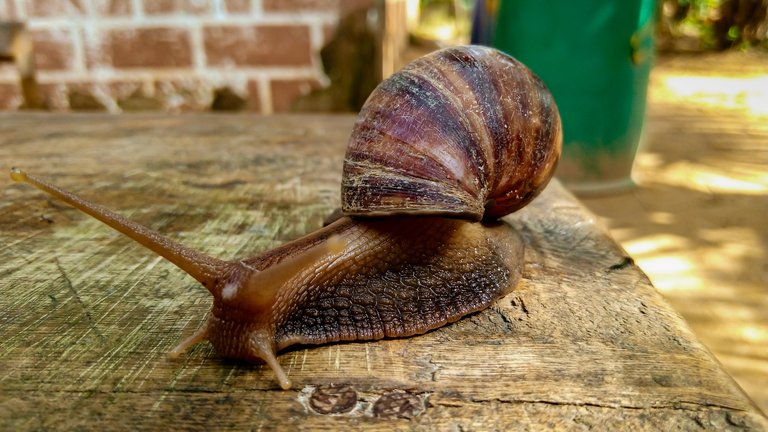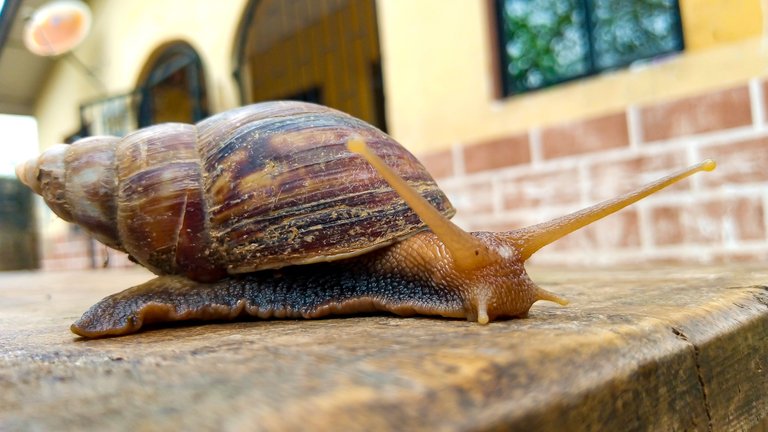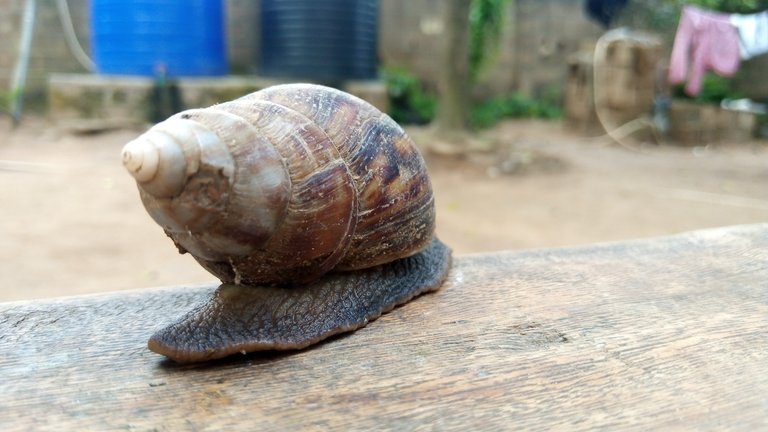A few days ago I spotted a relatively small Giant African snail close to my tap and did a short video. (To watch the video click here).
I got interested in knowing more about its nature and hopeful get some information to add to the hive communities. So I decided to research more.

Snail farming is a very lucrative agricultural business but not so popular among individuals who want to venture into farming due to its low capital intensity. Presently, it provides one of the finest opportunity to grow a business within a short period of time. Snail has a huge demand across the global market because of its taste, nutritional value and it's entire usage of even the shells.
It's meat contains high amount of protein, iron, magnesium, calcium, vitamin A and quite low in fat. Snail pie recommended as a source of protein and iron for school aged children and young mothers which contributes in the fight against anaemia (iron deficiency).
The economic value of snail farming can not be overemphasized, some farmers and the likes consider this kind of farming as a good money spinning venture and quite advisable for young youths to venture into. You can make good earning from snail farming within a very short time and you needn't wear dirty clothes as is the repellant factor that most young minds run away from.

Land snails belongs to the class of Molluscan in the Animalia kingdom, Gastropod also known as Congo Meat. In many parts of Africa, this slimy animal has names
that has been given to it in different tongues. In Nigerian for instance, it is called Igbin by the Yoruba people in the west, ejula by the Igbos in the eastern part and katantanwa by the Hausas in the north. With so many species scattered across the globe, the types we would be considering today is the Giant African snail which is suitable for commercial Snail Farming in Africa.
Putting cost and time into consideration, snail farming is a low risk business and quite profitable unlike many other livestock businesses. Snail farming requires very little start up and operating funds. With as little as N50,000 to N150,000 (Nigerian naira) depending on the size of marked out for the farm.

Starting Snail Farming in Nigeria
Like other ventures, there are steps to begin with if success is to be recorded on the long run. Snail farming has its own steps not just in Nigeria but wherever the climatic conditions favours the breeding of snails. As always, you have to go through some step by step processes. However, for the purpose of this article I have described some steps here for starting commercial snail farming business using Nigeria as a case study.
Soil
The soil is the main habitat of snails, For a successful snail farm, the land selected for this business must contain most of the components and chemical substances which are necessary for the survival of the snails. For this reason, not all types of soil are suitable for commercial snail farming.
The shell of the snail which is mainly calcium derived mainly from the soil. They drink water from the soil and also lay their eggs into the soil. A suitable piece of land with availability of all types of necessary soil components for the snails needs to be accessed before kicking off the farm.
The suitable soil must be balanced, not too dry, not waterlogged, and not acidic. The most desirable soil for snail is sandy soil, loamy soil with low water holding capacity and balanced pH level is perfect for snail farming.
Windspeed
However, it is snails are known to be easily dehydrated. Dryness occurs in snails due to moisture lose caused by wind. Hence, it will be advisable to select a location for the establishment of the farm.
To prevent the snails from losing water from their body quickly, place the farm in wind protected place void of any wind interference using wind breakers such as trees with wide branches or enclosed in between two brick fence. Though an area with many trees makes the perfect environment for snail farming.
Sourcing
Baby snails are called baby snails generally but for the purpose of this article I'll be terming the first set of snails in the farm as Fingerlings borrowed from fish farming.
It is advisable to get snails directly from the forest or hunted in thick bushes rather than buying from the market because most often times they have been exposed to sunlight and already dehydrated.
Assuming you do not want to risk going deep into the bush to hunt for snails going by the fact that snails are only spotted at early dawn or late into dusk. You can still get them in the bush with a very simple technique
- Clear a little portion of the bush during rainy season and scatter spicy fruits like pawpaw, pineapple, plantains and bananas. This attracts them to the cleared portion of land after a couple of hours you will be able pick up snails suitable for rearing. Though not in large quantity but if the procedure is repeated the right quantity to start with is sure. This technique attracts snails of different species.
- Another technique an intended snail farmer can adopt is picking snail eggs. The market place is a good spot to see eggs where harvested snails are sold. This technique is sure to give the best fingerlings for rearing. Check the potency of the eggs which are expected to be fresh and not lost fertility due it's exposure to sunlight.
Put the eggs inside a container wity wet sand and covered with coco-yam leaves. An average waiting period of 21 to 28 days, the eggs would hatch into baby snails.
Snailery
Snails are housed in trenches dug about 10inches into the earth protected around by a concrete wall and covered with a wired lid.
Remember the earth must not be waterlogged because as much as snails thrive more in cold places too much humidity is bad for business. Also during the dry/sunny season, leaves can be used to regulate the temperature of the abode.
Predators
As much as the wire keeps the snails from escaping out it is also useful in keeping away rats and snakes or any other predators from invading the snails in the snailery. Aside from these bigger predators, the farmer should be cautious of ants and termites.
Diseases
There aren't too many diseases associated wwith snails except for the fungus and bacterial diseases. Spread by contact have only been noticed in overcrowded cages.
During the dry seasons, it is ideal to irrigate the snail farm regularly else the snail will hibernate.
NOTE: If there is drought, snails can hibernate up to two years as is the case for desert snails.
Feeding
The kind of food the snail eats ensures its proper growth. It helps the snails grow their tissues and also calcium for growing shells.
- Leaves
- Fruits
- Water
Monitor their growth, like fish farming often separate the big ones from the small ones. It take about 16 months the snail to be ready for harvesting.
Harvesting
Collect the snails and the edge of the sole of it's shell, when it has become so firm it's a sign that the snail wouldn't grow again. You can repeat this collection once in 2weeks.
After this, the matured snails must be kept in a cage for about seven days during this period their digestive system completely gets rid of the soil in them. While this process is ongoing, the snails receive no more food or water. With temperature of about 5 degrees, they can survive for 2 months.

HEALTH BENEFITS OF SNAIL CONSUMPTION
Protein
Protein is essential for body building and repairing worn out muscles, and is better at filling than carbohydrates and fats. Most people turn to seafood thinking it contains more protein compared mammals, but actually, snails have more. Snail contains 16.1 g which is 32% DV protein. This amount is more than all other sources except mutton which contains 27 grams of protein in 100 grams of meat.
Protein stored in the cells have a major role to play in biological reactions. As a means of transport and storage, the protein contained in myoglobin and hemoglobin helps transport oxygen in erythrocytes. The form of fibers of the proteins called collagen has a function to maintain the strength and durability of the bones and skin for mechanical support.
Iron
Snail meat contains in iron (about 3.5 mg which is 19% of DV). Iron, a vital substance needed to ensure the production of the required number of blood cells every day.
In circulating oxygen, iron needs the help from other food nutrients such as protein which later merges to create hemoglobin (in red blood cells) and myglobin (in the muscle fibers).
Lack of iron in the human body could lead to chronic fatigue and anemia
Vitamins
snail meat contains a lot of vitamins like vitamin A", vitamin E, vitamin B1, B3, B6 and B12. Vitamin A which is helpful to the cleared vision, vitamin E acting as an antioxidant and, Vitamin B1, B3, B6 and Vitamin B12 are essential vitamins needed to prevent and control diabetes.
Also snails contains vitamin E which is good for the regeneration of cells and subsequently skin care. Niacin in the carbohydrates metabolism to produce energy and folate very good for the pregnant women.
Magnesium
Magnesium which is needed by our bodies to maintain normal blood pressure and keep the heartbeat at a regular pace. It also strengthens bones. Needed for about 325 enzymatic reactions, including the synthesizing of fats, neural activities, proteins and nucleic acids, muscle relaxation and contraction, bone metabolism and cardiac activity.
According to the United States Department of Health and Human Services, magnesium is recommended per day for men aged 19-30 years and also about 420 mg for those over 30 years old. Women under 30 years are recommended intake of 300 mg of magnesium per day.
Selenium
Selenium an mineral and nutrient that fight diseases such as cancer and heart diseases. Selenium would synergies with vitamin E, both are powerful antioxidants that prevents ageing and hardening of tissues via oxidation.
Omega-3
Snail contains Omega-3 fatty acids, Omega -3 fatty acid s are types of polyunsaturated fat that can be produced by our body and it is important and essential because it forms EPA (Eicosapentaenoic acid), DHA (Docosahexaenoic Acid) and ALA (a-linolenic acid).
Again the American Heart Association (AHA) recommends that a person must meet atleast 5-10% of daily calories from omega-6 fatty acids. Omega-6 needed for healthy adults is about 1-3g/day.
All these (but not secluded to) are the major health benefits of snail consumption. There are other nutrients like cholin, snail meat contains fat (mainly polyunsaturated fatty acid), calcium, phosphorus, copper, zinc. It also contains amino acids arginine and lysine more than a whole egg.
Snail meat also contains healthy essential fatty acids such as linolenic and linoleic acids.
ADVANTAGES OF SNAIL FARMING
- Demand: So long as responsible snail rearing continues, snail demand would be increasingly sorted daily even in fast food centers and eateries.
- MEDICINE: Medically, there is concern about eating healthy and natural. Doctors advice consumption of more natural habitats and less refined products.
The nutritional value associated with snail meat can compete with other meats like poultry, pork and beef. - AVAILABILITY: Snails reproduce more than once in a year and in large quantities too. They adapt to most climates and can be reared anywhere in the world.
- COST: Feeding snails is cheap and easy.
Their food is mostly vegetables. However, to make them grow bigger and larger, there are flours enriched with calcium you can purchase in wholesale at a low cost.
THINK ABOUT THIS
A hundred thousand snails after a year or two sold at the rate of 100 naira each (highly reduced price) will give you about 10 million naira
Ain't that a good investment? For something that barely takes your time and needs less attention.
I hope this piece has been helpful especially to my new friend @mistakili and his single snail which he's waiting to consume.
Don't be a stranger, I would like to hear from you. Please drop your feedbacks in the comments section. Hit the Follow button for current posts.
Read also
SCULPTURE: HOW TO MAKE A FEMALE BUST (With pictures)
SCULPTURE: TRICKS AND STEPS
THE VOID
HOUSE FLY
ACCOUNTABILITY: NIGERIAN DREAM
INTELLECTUAL RIGHTS RESERVED
FACEBOOK, TWITTER,
This post was published on Hive.io blockchain.
Source
Plagiarism is the copying & pasting of others work without giving credit to the original author or artist. Plagiarized posts are considered fraud and violate the intellectual property rights of the original creator.
Fraud is discouraged by the community and may result in the account being Blacklisted.
If you believe this comment is in error, please contact us in #appeals in Discord.
#posh
https://mobile.twitter.com/TentaclesMedia/status/1283363324412002304
Congratulations @ralphsam2! You have completed the following achievement on the Hive blockchain and have been rewarded with new badge(s) :
You can view your badges on your board And compare to others on the Ranking
If you no longer want to receive notifications, reply to this comment with the word
STOPDo not miss the last post from @hivebuzz:
Support the HiveBuzz project. Vote for our proposal!
Wow, so cool! :)
!discovery 30
Thank you for stopping by...
I really hoped it was educative.
Yes it is. I had never seen them so close! Moreover, I love everything related to biology and nature :) good job
This post was shared and voted inside the discord by the curators team of discovery-it
Join our community! hive-193212
Discovery-it is also a Witness, vote for us here
I have always been interested in snail farming. This post dropped the basis and I have a good grasp of what's all about . Thanks for sharing . This is awesome
Am currently learning snail farming. Thanks for this information
!hw ban
Mass plagiarism scam.
They are already banned.